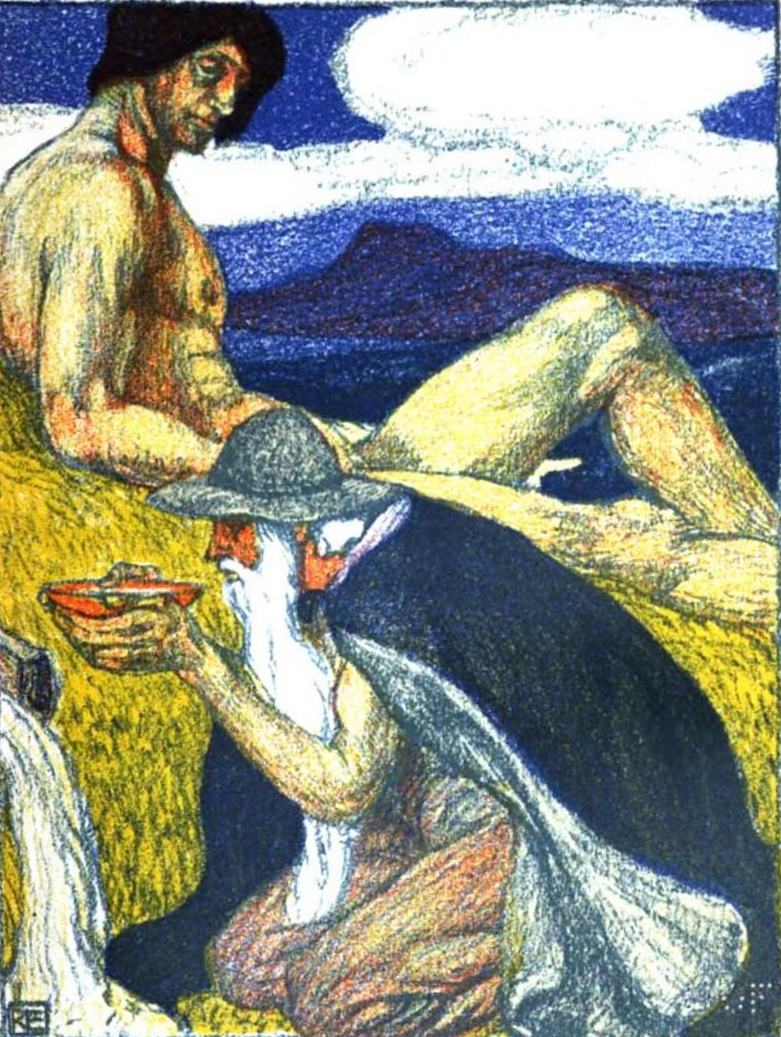|
Mímisbrunnr
In Norse mythology, Mímisbrunnr (Old Norse " Mímir's well"Simek (2007:216).) is a well associated with the being Mímir, located beneath the world tree Yggdrasil. Mímisbrunnr is attested in the ''Poetic Edda'', compiled in the 13th century from earlier traditional sources, and the ''Prose Edda'', written in the 13th century by Snorri Sturluson. The well is located beneath one of three roots of the world tree Yggdrasil, a root that passes into the Jötunheimr where the primordial plane of Ginnungagap once existed. In addition, the ''Prose Edda'' relates that the water of the well contains much wisdom, and that Odin sacrificed one of his eyes to the well in exchange for a drink. In the ''Prose Edda'', Mímisbrunnr is mentioned as one of three wells existing beneath three roots of Yggdrasil, the other two being Hvergelmir, located beneath a root in Niflheim, and Urðarbrunnr. Attestations ''Poetic Edda'' In the ''Poetic Edda'' poem ''Völuspá'', a völva recounts to Odin th ... [...More Info...] [...Related Items...] OR: [Wikipedia] [Google] [Baidu] |
Yggdrasil
Yggdrasil (from Old Norse ), in Norse cosmology, is an immense and central sacred tree. Around it exists all else, including the Nine Worlds. Yggdrasil is attested in the ''Poetic Edda'' compiled in the 13th century from earlier traditional sources, and in the ''Prose Edda'' compiled in the 13th century by Snorri Sturluson. In both sources, Yggdrasil is an immense ash tree that is central to the cosmos and considered very holy. The gods go to Yggdrasil daily to assemble at their traditional governing assemblies, called things. The branches of Yggdrasil extend far into the heavens, and the tree is supported by three roots that extend far away into other locations; one to the well Urðarbrunnr in the heavens, one to the spring Hvergelmir, and another to the well Mímisbrunnr. Creatures live within Yggdrasil, including the dragon Níðhöggr, an unnamed eagle, and the stags Dáinn, Dvalinn, Duneyrr and Duraþrór. Scholars generally consider ''Hoddmímis holt'', ''Mímameiðr' ... [...More Info...] [...Related Items...] OR: [Wikipedia] [Google] [Baidu] |
Urðarbrunnr
Urðarbrunnr (Old Norse "Well of Urðr"; either referring to a Germanic concept of fate—''urðr''—or the norn named UrðrSimek (2007:342).) is a well in Norse mythology. Urðarbrunnr is attested in the ''Poetic Edda'', compiled in the 13th century from earlier traditional sources, and the ''Prose Edda'', written in the 13th century by Snorri Sturluson. In both sources, the well lies beneath the world tree Yggdrasil, and is associated with a trio of norns (Urðr, Verðandi, and Skuld). In the ''Prose Edda'', Urðarbrunnr is cited as one of three wells existing beneath three roots of Yggdrasil that reach into three distant, different lands; the other two wells being Hvergelmir, located beneath a root in Niflheim, and Mímisbrunnr, located beneath a root near the home of the frost jötnar. Scholarly theory and speculation surrounds the well. Attestations Urðarbrunnr is attested in the following works: ''Poetic Edda'' In the ''Poetic Edda'', Urðarbrunnr is mentioned in ... [...More Info...] [...Related Items...] OR: [Wikipedia] [Google] [Baidu] |
Hvergelmir
In Norse mythology, Hvergelmir (Old Norse: ; "bubbling boiling spring"Orchard (1997:93)) is a major spring. Hvergelmir is attested in the ''Poetic Edda'', compiled in the 13th century from earlier traditional sources, and the ''Prose Edda'', written in the 13th century by Snorri Sturluson. In the ''Poetic Edda'', Hvergelmir is mentioned in a single stanza, which details that it is the location where liquid from the antlers of the stag Eikþyrnir flow, and that the spring, "whence all waters rise", is the source of numerous rivers.Thorpe (1866:23). The ''Prose Edda'' repeats this information and adds that the spring is located in Niflheim, that it is one of the three major springs at the primary roots of the cosmic tree Yggdrasil (the other two are Urðarbrunnr and Mímisbrunnr), and that within the spring are a vast amount of snakes and the dragon Níðhöggr. Attestations Hvergelmir is attested in the following works: ''Poetic Edda'' Hvergelmir receives a single mention in the ... [...More Info...] [...Related Items...] OR: [Wikipedia] [Google] [Baidu] |

